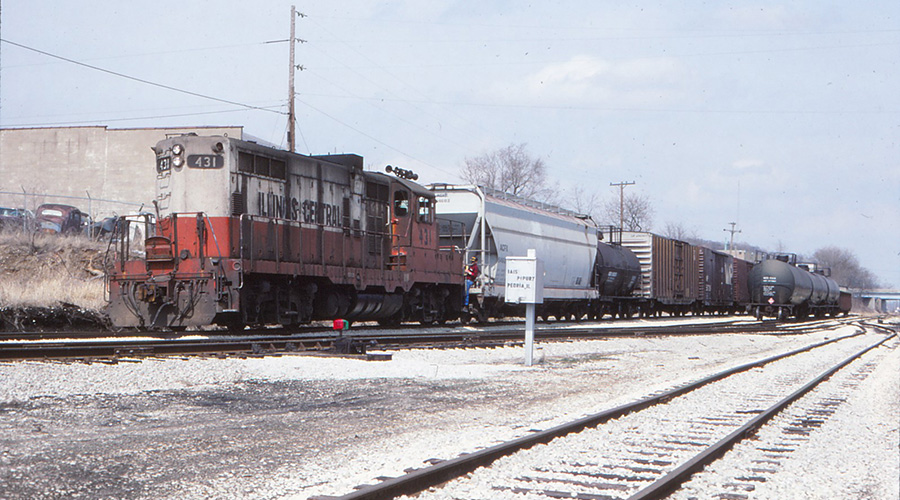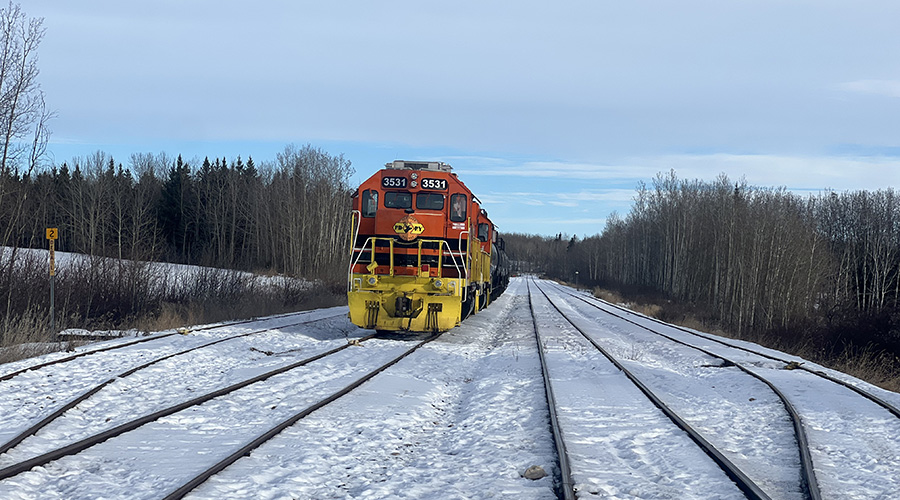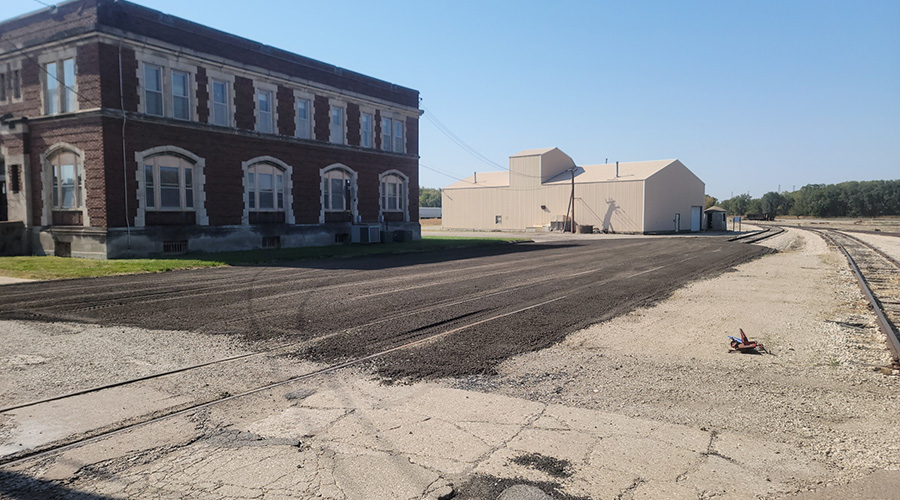Iowa Interstate turns 40 after turning a corner in the '80s
10/18/2024
By Jeff Stagl, Managing Editor
Something significant for Iowa Interstate Railroad LLC (IAIS) is occurring in October. The regional is turning 40.
IAIS was formed on May 17, 1984, but didn’t commence operations until October of that year. The regional’s records indicate that the first IAIS train was moved on Nov. 4, 1984.
Real estate firm Heartland Rail Corp. purchased 553 miles of former Chicago, Rock Island and Pacific Railroad track from Council Bluffs, Iowa, to Bureau, Illinois, for $31 million on Oct. 10, 1984. Heartland Rail selected IAIS — a separately owned company — as the line’s operator.
In April 1985, trackage rights to Chicago were secured from CSX and Metra. Then rail service from Council Bluffs to Chicago was restored for the first time since the bankrupt Rock Island Railroad was liquidated in 1980.
Today, IAIS operates 580 miles of track, with a nearly straight mainline from Council Bluffs to Chicago and a branch line from Bureau to Peoria, Illinois. Based in Cedar Rapids, Iowa, the regional interchanges with all six Class Is and a number of short lines, and transports a variety of products, from 100-car unit trains of ethanol to single-car shipments of organic popcorn.
 Shown: An undated photo depicting the railroad’s early years. The train pulled by the Illinois Central Railroad locomotive was moving through Peoria, Illinois. Iowa Interstate Railroad/A.O. Hunt
Shown: An undated photo depicting the railroad’s early years. The train pulled by the Illinois Central Railroad locomotive was moving through Peoria, Illinois. Iowa Interstate Railroad/A.O. HuntWhen IAIS was formed, it wasn’t considered a popular move in the rail industry because it posed a fourth mainline between Omaha, Nebraska, and Chicago, says Henry Posner III, the chairman of IAIS and Railroad Development Corp., which acquired a stake in the regional in 1991 and became sole owner of IAIS in 2004. The idea of another mainline — and an abandoned one at that — during the dawn of deregulation was widely considered delusional, he says.
“Many at time preferred the railroad didn’t exist,” says Posner. “A north-south railroad would have picked up the trackage if it wasn’t an east-west route.”
In addition to that rather inauspicious beginning, IAIS struggled financially in its early years, to the point serious discussions were held about entering bankruptcy proceedings. But the railroad’s prospects got better over time, says Posner.
Helping to guide the regional during the bad and good times were the following IAIS presidents (and their years of service):
• Harry Meislahn, the first president, 1984 to 1986;
• Paul Banner, 1986 to 1991;
• Fred Yocum, 1991 to 1998;
• Doug Christy, 1998 to 2000;
• Jon Roy, 2000 to 2002;
• Dennis Miller, 2002 to 2012;
• Jerome Lipka, 2012 to 2017; and
• Joe Parsons, the current president and CEO. Parsons, who joined IAIS in September 2013 as chief operating officer, served shortly as general manager before becoming president and CEO in September 2018.
 Another undated photo shows IAIS operations in Iowa City, Iowa. Last year, the railroad built a transload facility at an industrial campus in the city. Iowa Interstate Railroad/A.O. Hunt
Another undated photo shows IAIS operations in Iowa City, Iowa. Last year, the railroad built a transload facility at an industrial campus in the city. Iowa Interstate Railroad/A.O. HuntParsons cites solid safety as an achievement at IAIS over the years. Efforts to bolster safety resulted in the regional winning three E.H. Harriman Awards — former annual safety awards in the rail industry — including a gold award. In addition, the railroad once logged an entire rolling year without a reportable injury.
“I am proud of our safety history. We have built a safety culture,” says Parsons.
Another thing IAIS leaders are proud of? Not needing to adjust the workforce at any point over the past four decades.
“We have never had a layoff — never, ever,” says Posner.
There have been a number of other achievements and seminal moments at IAIS over the past 40 years. Here are some of them and the year they occurred:
• Piggyback service was initiated in 1985;
• Double-stack intermodal service commenced in 1987, with intermodal ramps in Council Bluffs and Blue Island, Illinois;
• Heartland Rail purchased IAIS in 1991 to combine the operating entity with the track structure’s owner;
• Archer Daniels Midland became an investor in the railroad in 1995, then later acquired a controlling interest;
• Offices were consolidated to a new facility in Cedar Rapids in 2001;
• The railroad purchased 22 rebuilt GP38-2 and four SD 38-2 locomotives in 2004;
• IAIS obtained a $32.7 million Railroad Rehabilitation and Improvement Financing (RRIF) program loan in 2005 to upgrade 300 miles of track between Atlantic, Iowa, and Bureau to accommodate 286,000-pound rail cars and increase train speed to 40 mph;
• The regional garnered a second RRIF loan — for $9.35 million — in 2006 to purchase 22 GP-38-2 locomotives from GATX Rail;
• A transaction was completed in 2006 to lease 32 miles of track from CSX between Utica and Henry, Illinois;
• IAIS purchased the Council Bluffs Railway property in Council Bluffs from OmniTRAX Inc. in 2006;
• The railroad purchased 12 new 4,400-horsepower locomotives from GE Transportation in 2008 (two more units were bought in 2010 and three more were procured in 2015);
• The Council Bluffs intermodal ramp was upgraded in 2010;
• A new car shop opened at Pietrandrea Yard in Silvis, Illinois, in 2011;
• The Dennis H. Miller Locomotive Works facility opened in South Amana, Iowa, in 2012;
• The William J. Duggan Bridge in Booneville, Iowa, opened in 2020, replacing a 119-year-old through-truss bridge;
• iCON Infrastructure Partners V became a 40% partner in IAIS in 2021;
• A new transload facility at an industrial campus in Iowa City, Iowa, opened in 2023; and
• Founding IAIS Chairman Paul Banner died at the age of 102 in 2024.
Employing GE Evolution Series locomotives since 2008 has enabled the regional to become a leader in fuel-usage metrics, says Posner. In addition, the new locomotive fleet became a tipping point for IAIS, leading to more reliable service and the need for the new shop in South Amana, says Parsons.
 In 2012, the regional opened the Dennis H. Miller Locomotive Works facility in South Amana, Iowa. The shop is named after the former IAIS president who led the railroad from 2002 to 2012. Iowa Interstate Railroad/Rafter VanDriessche
In 2012, the regional opened the Dennis H. Miller Locomotive Works facility in South Amana, Iowa. The shop is named after the former IAIS president who led the railroad from 2002 to 2012. Iowa Interstate Railroad/Rafter VanDriesscheGoing forward, IAIS plans to continue emphasizing reliable operations and offering a host of services, including intermodal, new rail facility development, and container and rail-car storage.
“We can grow by focusing on customers, industrial development and transloading,” says Parsons.
For example, IAIS in May broke ground on a Renewable Energy Distribution Center in Newton, Iowa, that’s designed to provide wind energy tower component shippers a place to safely transload and store their parts.
Covering 50 acres and expected to open in first-quarter 2025, the center will be used to distribute components all around the Midwest, says Parsons.
Compared with similar distribution centers, the Newton facility will be unique because of its location and size, he says. The center will be located near wind blade and wind tower manufacturing plants.
There are similarly promising developments on the horizon for IAIS. About 55 miles of the railroad’s track to Moline, Illinois, might become a branch line for Amtrak’s California Zephyr service between Oakland, California, and Chicago. That project still is in the design phase, says Posner.
In addition, another federal grant — this time through the Consolidated Rail Infrastructure and Safety Improvements (CRISI) program — might be in the offing.
“We have applied for a CRISI grant for bridge replacements that would be done in 2025,” says Parsons.


